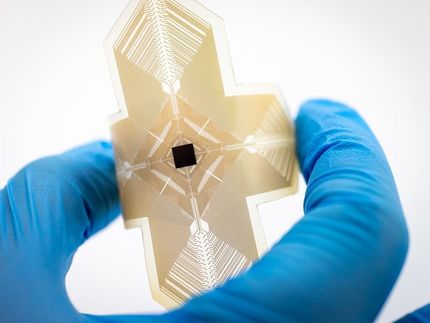Active Implants: How Gold Binds to Silicone Rubber
Flexible electronic parts could significantly improve medical implants. However, electroconductive gold atoms usually hardly bind to silicones. Researchers from the University of Basel have now been able to modify short-chain silicones in a way, that they build strong bonds to gold atoms.
Ultra-thin and compliant electrodes are essential for flexible electronic parts. When it comes to medical implants, the challenge lays in the selection of the materials, which have to be biocompatible. Silicones were particularly promising for application in the human body because they resemble the surrounding human tissue in elasticity and resilience. Gold also poses an excellent electrical conductivity but does only weakly bind to silicone, which results in unstable structures.
Molecular conductive glue
An interdisciplinary research team of the Biomaterials Science Center and the Department of Chemistry at the University of Basel has developed a procedure that allows binding single gold atoms to the ends of polymer chains. This procedure makes it possible to form stable and homogeneous two-dimensional gold films on silicone membranes. Thus, for the first time, ultra-thin conductive layers on silicone rubber can be built.
The novel approach: Firstly, the thermal evaporation of organic molecules and gold atoms under high-vacuum conditions permits preparing ultra-thin layers. Secondly, their formation from individual islands to a confluent film can be monitored with atomic precision by means of ellipsometry. Using masks, the sandwich structures fabricated can convert electrical energy into mechanical work similar to human muscles.
Energized silicone rubber
These dielectric artificial muscles could simultaneously serve as pressure sensors and may, in the future even be used to harvest electrical energy from body movement. For this purpose, the silicone membranes are sandwiched between electrodes. The relatively soft silicone then deforms according to the applied voltage.
So far, the silicone membranes were several micrometres thick and required high voltages to reach the desired strain. These new nanometer-thin silicone membranes with ultra-thin gold electrodes allow operation through conventional batteries. To bring such a product to the market, the production costs would have to be reduced drastically. However, Dr. Tino Töpper, first author of the study, is optimistic: «The perfect experimental control during the fabrication process of the nanometer-thin sandwich structures is a sound basis for long-term stability – a key prerequisite for medical applications».
Original publication
Most read news
Original publication
Tino Töpper, Samuel Lörcher, Hans Deyhle, Bekim Osmani, Vanessa Leung, Thomas Pfohl, and Bert Müller; "Time-resolved plasmonics used to on-line monitor metal-elastomer deposition for low-voltage dielectric elastomer transducers"; Advanced Electronic Materials; 2017
Organizations
Other news from the department science

Get the life science industry in your inbox
By submitting this form you agree that LUMITOS AG will send you the newsletter(s) selected above by email. Your data will not be passed on to third parties. Your data will be stored and processed in accordance with our data protection regulations. LUMITOS may contact you by email for the purpose of advertising or market and opinion surveys. You can revoke your consent at any time without giving reasons to LUMITOS AG, Ernst-Augustin-Str. 2, 12489 Berlin, Germany or by e-mail at revoke@lumitos.com with effect for the future. In addition, each email contains a link to unsubscribe from the corresponding newsletter.

















































